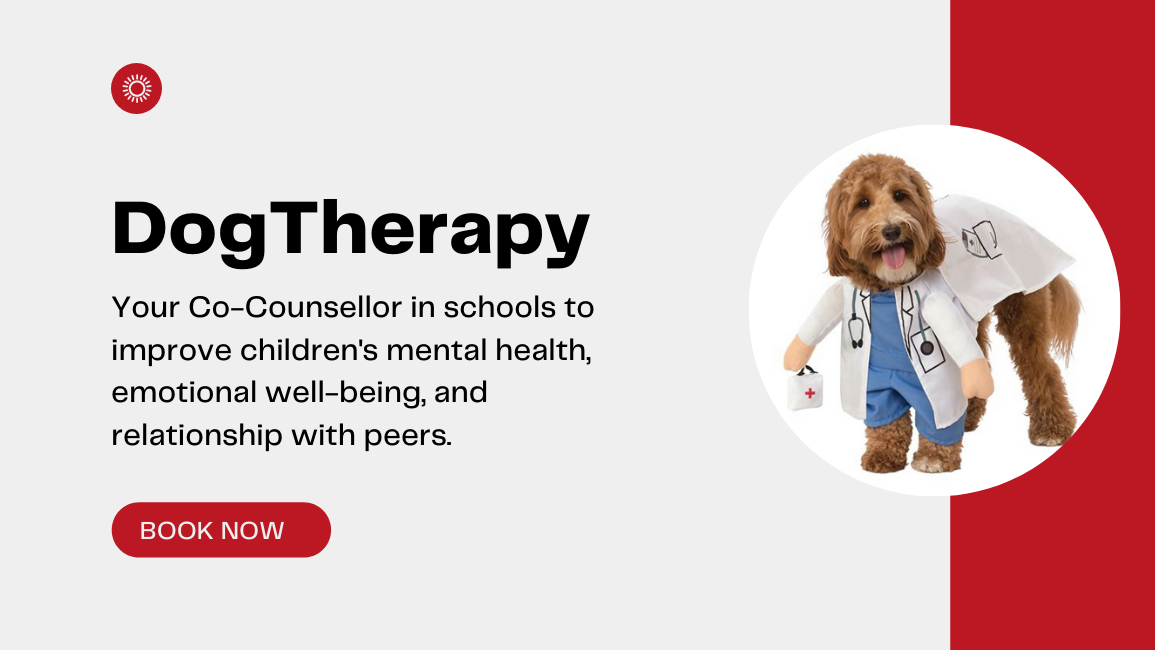
Virtual DogTherapy: Emotional support animals at virtual classrooms to improve children’s mental, emotional, and social well-being.
By FRANKIE KOK
Overview
Challenge

“Dogs are the superheroes of the school with the power to help kids be happy, safe, and supported. The dogs bring levels of anxiety down, anger, frustration. it creates this amazing environment for 685 kids here in our school community, that they just wouldn’t get anywhere else.”
– Kim Pruitt, School Counsellor from the Waller Independent School District.

While more students are suffering from mental health issues due to the social isolation and loneliness resulting from the pandemic, emotional support animals like service dogs have been proven by research to be a great companion with the students at school during the exams time to reduce stress and improve well-being.
Integrate virtual therapy dogs in the classroom experience by partnering with existing service dog organizations: https://petpartners.org/virtualvisits/ and the school counselors to create a psychologically safe space for the students to open up and connect emotionally through video zoom chat.

School staff can also partner with not-for-profit organizations to bring virtual dog therapy to students in school. OHNF is a medical non-for-profit that provides 1:1 online therapy session with children for free, and anyone can book a session with the dog using the calendly’s calendar.
 ..
..

Virtual Pet Events at Stanford University
Stanford University’s Academic Services has been hosting virtual pet events with zoom to bring different categories of animals (e.g. dogs, cats, bunnies, bees, lizards, plants, etc) for students to interact with them virtually. These sessions offer virtual live interaction of seeing some dogs (or cats and other surprise animals) play, training, and Q&As providing students a moment of joy and connection with the animals.



Expected Impact

“A connection with an animal just brings calmness to my mind, giving me the distraction from my pain, and connecting virtually is pretty much the same thing as face to face. It’s been a great relief in a difficult time.”
“Any time I have a child that is anxious, one of the ways that I can kind of get them to talk and open up, especially if they’re not one to share or share very openly if they just have that time to sit and pet her then they start talking. Afterward, I will get them filled up google form to share their feeling, and usually, they are open to sharing more excitement after having a video chat with dog” Cowell said
Pets improve emotional health.
Research has linked pets with lower stress, decreased feelings of loneliness, and increased opportunities for socialization. Caring for a living creature inspires purpose and meaning. Studies have also shown that pets motivate children to focus on a task. A therapy dog has been brought virtually to aid children in learning to read.
E Ko HJ, Youn CH, Kim SH, Kim SY. Effect of Pet Insects on the Psychological Health of Community-Dwelling Elderly People: A Single-Blinded, Randomized, Controlled Trial. Gerontology. 2016;62(2):200-9. doi: 10.1159/000439129. Epub 2015 Sep 18
Pets help children learn and socialize.

“Reading with the dogs helps build confidence and focus because the dogs aren’t going to judge or correct the children’s readings. I’ve even heard from several of the parents that the children practice at home to read to the dogs.”. Pets can also help children socialize. One study found that when a guinea pig was placed in a classroom, children with autism became more social, smiled and laughed more, and were less stressed.
O’Haire ME, McKenzie SJ, Beck AM, Slaughter V. Social Behaviors Increase in Children with Autism in the Presence of Animals Compared to Toys. https://doi.org/10.1371/journal.pone.0057010 Feb 2013
Expected Impact
- Children have positive interaction with the dogs, more smile and joy spread across campus
- Parents and teachers report more positive behavior and interaction amongst children
- Children’s motivation, social connection with peers, and the agency of learning in learning improved Stories of the impact of children sharing with others
- Children will also feel less fear and anxiety, reducing the stress and isolation they felt during the pandemic.
- Having emotional support animals will also help children develop more focus in learning, and hence helping them to catch up with their academic learning
Adopt & Adapt
What is required for other school communities to adopt or adapt your solution?
- Partner with existing organizations that have service dogs that are registered
- Create awareness and provide marketing of the service dogs event to the students and staffs
- Have virtual service dogs available to support the school counselors to enhance the psychology service provided to the students who are in emotional need.
- Time from the psychology counselor staff or teachers to organize the virtual dog sessions in school
What resources does it require?
- Zoom Virtual Account
- A staff member to partner with dog organization, to liaise, organize, and facilitate the session with dogs and students, and to handle the dog (ideally, a psychologist counselor who understand dogs) or
- Have the involvement of an experienced dog handler from the partner organization.
- Some dogs might need additional time and training for virtual connection, but there are owners who have volunteer their animals to provide these services, so it’s an easy way to connect with registered and certified pets at a minimal cost.
Does it generate buy-in and interest?
Service Dogs have been welcome and available at school during exam time and with the pandemic, the dogs can now be showing greater participation through virtual programs
Does it align with existing policies and/or curricula?
Yes, it can be integrated with the existing curriculum and classroom teaching to provide a moment of joy to the students in learning. There is no disruption or change in the academic lessons.
How long would it take to implement?
It could take 2-4 weeks to contact and partner with the organizations that provide these services, and organize a virtual event to support the school counselor and teachers to connect with the children.
